Thursday at Broadway.
A certain lack of materials - to wit, no more concrete blocks in store - forced John to lay bricks along the back on Thursday.
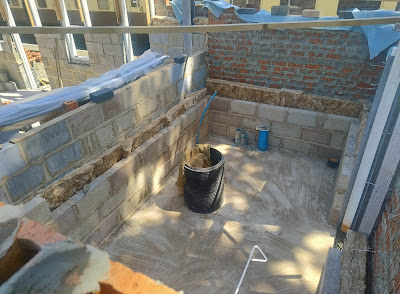
Under the green timetable on Thursday we had a diesel hauled train (the Peak), and a steam hauled one (35006).
It's getting very dry now, and this big loco set several small fires in the pine needles at Broadway. We put out two of them; the station staff another two. Last week we put out another one, by the signal box. The old MN does seem to leak sparks from somewhere.
Friday at Broadway.
31 degrees announced, and we had a delivery of materials coming too. This meant a lot of manual labour - oh-oh.
The lorry dropped off a pallet of concrete blocks, and another of Thermalite blocks. This was all on the pavement outside the station. No RRV until August, so we were obliged to shuttle this down one platform, over the barrow crossing, and back up the other. The lorry driver was kind enough to split the pallet of concrete blocks into three, so that were were able to ferry 18 at a time, using Neal's pallet truck (of course Neal has a pallet truck, don't you have one?)The Therrmalite blocks were lighter, so could be split into only two loads, one of which you can see Neal and John pull along platform 1. In the meantime, Yours Truly ((later assisted by Neal and John) heaved the concrete blocks into the store room, one at a time. The total weight of the concretes was 1.3 tons !
By 10.30 we had everything over on P2, and stacked inside the building. By now however it was 29 degrees, and we retreated to a windier P1 and collapsed on to the benches. There wasn't much enthusiasm to stand in the sun and lay bricks after that.
Monday in the greenhouse.
The temperature has dropped a few degrees, phew! Neal and Yours Truly spent a day in the greenhouse. While the roof structure is, in essence, finished, there are quite a few little bits that need to be added to the structure. Various plates and angles are needed to allow the fascia boards to be attached to the trusses, and brackets on top of the trusses will allow the corrugated iron sheets and glass to be attached.
Today we had two visitors from the Broadway maintenance gang. How was it all going? Dave and Keith certainly looked impressed, and Neal was only too happy to explain all.
Neal spent the day drilling holes, while Yours Truly ground off millscale on the table visible bottom right. There's a big pile - a wheelbarrow load - of brackets that will go half way up and on top of the trusses, as Neal is demonstrating here. They all have a carefully measured angle, so that they will sit straight when fixed to the slope.
The big plates that Neal is attaching to the ends of the trusses here were cleaned last week, and are typical of the bits and bobs that still need to go on. Up to eight holes need to be drilled in items like these, and Neal reckons that he still has about 200 to drill. Bolts will secure the plates in the first instance, then every bolt will need to be replaced by a proper rivet.
It's amazing how Neal knows exactly what to do, what goes where, and which holes have to be drilled where.
We never see a drawing being consulted - it's all 'up there' !
Another item worth mentioning from Monday is this loco on the unloading road:
It's BETTON GRANGE, about to go away (to the NNR, we ascertained.).
It's a busy locomotive, but of course the owning group needs to earn as much cash as possible now.
Tuesday at Broadway.
The forecast was a bit dire - showers, and high winds. We decided to have a go!
John would be working inside the store room, so to some degree sheltered from the wind and the rain.
We did quite well really, despite the squalls.
Here is a mid morning shot, showing a row of concrete blocks going on.
The pile in the middle was from a delivery on Monday, but at the end of the day it was considerably diminished. Well done, that block layer!
During the day we were joined by members of the S&T department, who were working to permit the activation of the signal box. It's really happening, hard to believe after such a long wait.
In the picture they are easing the compensators, which after years of non-use, had become stiff and touching each other.
The weather was still tolerable during the morning, but a burst of rain was forecast for 11 - 11.30, so we planned that period for our mid-morning coffee break. It's so nice to be able to drop into the Broadway cafe and enjoy a Cappuccino.
Back at the waiting room, we see John laying more blocks, cut to size with a huge cloud of white dust by Your Truly. At the end of the day John had consumed three mixes, and laid two courses of blocks, with the associated insulation.
There is no news of our specials from the brickworks.
We had two steamers during the day. Here's Foremarke Hall, about to steam into a stormy weather system, which completely obscured our normal clear view of Cleeve Hill down the line.
There followed a heavy downpour, which even overwhelmed the station's guttering and downpipe system.
It was originally a 4 inch system, but we built it as a 3 inch one.During the downpour (not so visible on these snapshots) the mid afternoon steam/diesel hauled train arrived, and quickly left, as no running round was required.This time it was a pair of class 20s , which we recognised straight away from a distance, due to all the whistling that was going on. We haven't seen this combination yet at Broadway.
2807 was on behind. It was raining heavily here. At least they were facing forward, and could hide behind the backhead.
After the train left, it continued to belt down.If you look carefully, you can see John, stoically laying down blocks, albeit somewhat sheltered by the rising walls of the store room.
Still, two courses of blocks by the end of the afternoon, that was certainly worth it.
Wednesday with the Usketeers.
Much better temperature - only 26 degrees. It made all the difference.
Today was a day about drainpipes. We installed the front one last week, but using temporary screws.
 |
| Dave removed the modern screws, and fitted hex bolts in their place. The swan neck at the bottom still needs sorting. |
The main job was at the back, where a broken downpipe led to a hole in the ground with an unknown, perhaps even blocked, destination.
It is extremely narrow round the back, and error made when the bit of land behind the weighbridge was sold off, and eventually turned into two houses. Damp is almost certainly building up in the narrow slot, and there isn't much we can do about it. The bottom of the slot is only just below the plinth, which is several rows too high.
Luckily the neighbours are friendly, and allowed us to work from their garden. We cut the old downpipe about halfway down (it is broken near the bottom), and on the left you can see Paul pulling through a new 6ft downpipe, which will run diagonally to the corner, and then round.
Here you can see Dave cleaning out the gutter (while we were there, why not?), and behind him you can see the new downpipe sloping diagonally to the corner.
So far, so good. But when we went to try out the next sections, we realiseed that we had failed to allow for crossing the plinth at the end of the new pipe system. A diagonal approach to that would look very awkward.
We had lunch, and chewed the fat.
After lunch the solution came to us, we would raise the point at which we intercepted the old downpipe, and reach the corner at a higher level.
This picture now shows the amended situation, with the old downpipe made shorter, and the new 6ft length reaching the corner at a point about 2ft higher.
Mid afternoon we had tea and Magnums in the cafe, which was quite busy. The diesel hauled train, sadly, was not. The second train out was hauled by 2807 in black livery, and looked a lot busier.
This picture, taken from the garden, shows the final layout, after a lot of trial and error. We have even put the fencing panel back in, after sawing a small hole into it for our pipe to pass through.
The last picture shows how far we got with the rear guttering layout - to the corner, and properly secured to the wall.
Now we have to buy some additional pipes and fittings, including another swan neck to get over the plinth below. With a bit of luck it will arrive before next time - watch this space.
PWay notes for Wednesday
A repeat visit to Gotherington, where some of the job of replacing flat bottom rail sleepers still remained to be done
Although the day started cool enough, as soon as the sun came out it becme very hot, and this hit productivity.
The interesting news item of the day was the first time use of the Milwaukee electric chair screw wrench.
Before we bought this, our weapon was the motor powered impact wrench. This suffered frequent breakdowns, and when operational, was extremely heavy to carry and operate, and also required you to bend half way over, a poor attitude for the back.
The new electric wrench is not only surprisingly light, it is tall, so that you can use it standing up, without bending. With its two handles at the top it looks like a pogo stick, so that's what we call it...
We liked it, sure enough!
An extract from:
THE GREAT WESTERN RAILWAY (LONDON) LECTURE AND DEBATING SOCIETY.
Yes, there was such a thing!
One item in a 1926 pamphlet that came across our desk was this one, which you might find interesting:
Anti-Aircraft gun damaged.
An unusual accident arising from unusual circumstances led to the disaster you see depicted. This is an anti-aircraft gun on a road motor lorry loaded on a ''Loriot'' despatched with others from South Lambeth to Watchet for Territorial manoeuvres.
The barrel, which normally pointed in the opposite direction to that shewn in the photograph, was intended to have been kept horizontal, first by a locking pin in the elevating apparatus, and secondly by a wire lashing around the muzzle, securing that end of the barrel in a metal crutch by attachment to the floor of the lorry.
On loading, these safeguards were assumed to have been taken because the gun was covered with a War Department sheet, but the pin had not been inserted, and the wire lashing and crutch had not been properly fastened.
The barrel became elevated during the journey, and on the train passing under Milley overbridge at Twyford, the gun rammed the bridge. The effect will be seen to have been quite bad for the gun.
Was that a bang I just heard, Fred? Nah, pass me my mash tin, will yer Mikey?




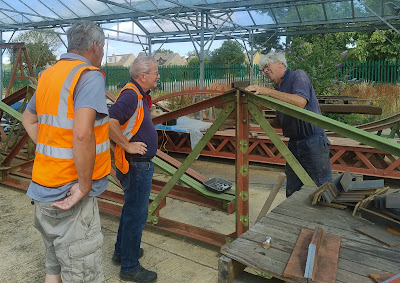




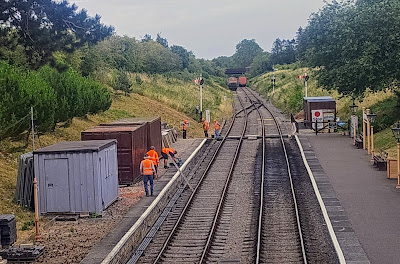





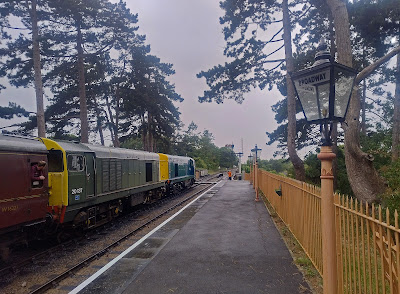









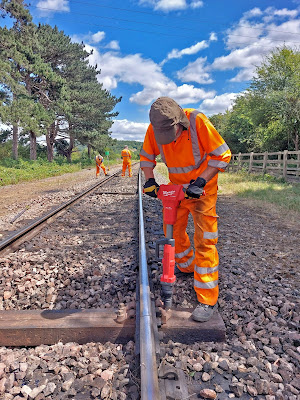

Thanks for taking the time to writ up this wonderful, extended, report!
ReplyDeleteIt's great to see that proper rivets will again be used in the canopy; it will be hard to tell that it wasn't built in the early 1900's. Then again, it's hard to tell that the _entire station_ is a product of the 21st Century! (I again wish there was some small, discreet tribute to Bill Britton, before everyone forgets his name.)
And I love the 'GWR' in the coffee! Are a lot of them like that, or was that a 'special'? Is it known who came up with that?
The 'GWR' Cappuccino is unique to Broadway. The form over which the chocolate is sprinkled was made by a cafe volunteer. It's great. We had a lot of customers in the cafe when the rain came :-)
DeleteA very interesting blog. I was watching the exploits by S&T at Broadway via webcam, and witnessed the remote working of the south points for a loco to run round, I assume from the signal box. I have to say that the whole procedure was far quicker than the fireman using the gtound frame, so roll on the commissioning date of the box!
ReplyDeleteNeal is, in deed, doing a stirling job in the concrete block laying in the 'store room'. I am surprised by the lack of reply from the brickworks. Do they want work or don't they? Having said that, there may be a reply soon.
The 'greenhouse' is a real handy thing to have for large job, outdoors work. Maybe it has found a reason for it to stay!
I must say, that the 'Milwaukee electric chair screw wrench', sounds at first off like ann instrument of torture or capital punishment!! Glad it works well and is liked, all in its propper working usage, of course.
The AA gun damage looks rather serious. Bet someone got called over the coals for that!! A 'Please explain' form at the very least from G.W.R. head office.
Regards, Paul.
Re concrete block laying. That should read John and not Neal. Neal is rightly famous for the canopy.
DeleteRegards, Paul.